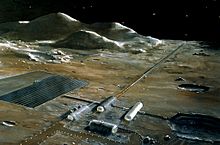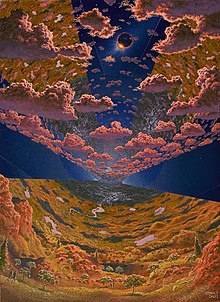JimBowie1958
Old Fogey
- Sep 25, 2011
- 63,590
- 16,753
- 2,220
I first saw this in Bezos speech the other day and I was impressed. I h ad never heard of them and yet they have been around for decades.
O'Neill cylinder - Wikipedia
They can be perfect controlled environments with everything placed for beauty, efficiency and safety.
Each would have a livable area of about the size of Guam and since the hydropnic farming would be in a lartge set of hydroponic spheres, it would be more living area than resource area. Most resources would come from mining the Moon, Mars and astroids that would be tugged in.
Thousands of these things could be built and the Earth turned into a giant park. There would be no pollution, no shortages, and if needed we could move them outside of the Suns expansion over the course of millions of years.
From the Wikipedia article:
The Island Three design, better known as the O'Neill cylinder, consists of two counter-rotating cylinders, each five miles (8.0 km) in diameter, and capable of scaling up to twenty miles (32 km) long.[5] Each cylinder has six equal-area stripes that run the length of the cylinder; three are transparent windows, three are habitable "land" surfaces. Furthermore, an outer agricultural ring, twenty miles (32 km) in diameter, rotates at a different speed to support farming. The habitat's industrial manufacturing block is located in the middle, to allow for minimized gravity for some manufacturing processes.
To save the immense cost of rocketing the materials from Earth, these habitats would be built with materials launched into space from the Moon with a magnetic mass driver.[1]
Design[edit]
Artificial gravity[edit]

A NASA lunar base concept with a mass driver (the long structure that extends toward the horizon that is a part of the plan to build O'Neill Cylinders)
The cylinders rotate to provide artificial gravity on their inner surface. At the radius described by O'Neill, the habitats would have to rotate about twenty-eight times an hour to simulate a standard Earth gravity; an angular velocity of 2.8 degrees per second. Research on human factors in rotating reference frames[6][7][8][9][10] indicate that, at such low rotation speeds, few people would experience motion sickness due to coriolis forces acting on the inner ear. People would, however, be able to detect spinward and antispinward directions by turning their heads, and any dropped items would appear to be deflected by a few centimetres.[9] The central axis of the habitat would be a zero-gravity region, and it was envisaged that recreational facilities could be located there.
Atmosphere and radiation[edit]
The habitat was planned to have oxygen at partial pressures roughly similar to terrestrial air, 20% of the Earth's sea-level air pressure. Nitrogen would also be included to add a further 30% of the Earth's pressure. This half-pressure atmosphere would save gas and reduce the needed strength and thickness of the habitat walls.[1][4]

Artist's depiction of the interior of an O'Neill cylinder, illuminated by reflected sunlight
At this scale, the air within the cylinder and the shell of the cylinder provide adequate shielding against cosmic rays.[1] The internal volume of an O'Neill cylinder is great enough to support its own small weather systems, which may be manipulated by altering the internal atmospheric composition or the amount of reflected sunlight.[5]
Sunlight[edit]
Large mirrors are hinged at the back of each stripe of window. The unhinged edge of the windows points toward the Sun. The purpose of the mirrors is to reflect sunlight into the cylinders through the windows. Night is simulated by opening the mirrors, letting the window view empty space; this also permits heat to radiate to space. During the day, the reflected Sun appears to move as the mirrors move, creating a natural progression of Sun angles. Although not visible to the naked eye, the Sun's image might be observed to rotate due to the cylinder's rotation. Light transmitted through glass at an angle is somewhat polarized, which might confuse pollinating bees.[1]
To permit light to enter the habitat, large windows run the length of the cylinder.[1] These would not be single panes, but would be made up of many small sections, to prevent catastrophic damage, and so the aluminum or steel window frames can take most of the stresses of the air pressure of the habitat.[1] Occasionally a meteorite might break one of these panes. This would cause some loss of the atmosphere, but calculations showed that this would not be an emergency, due to the very large volume of the habitat.[1]
Attitude control[edit]
The habitat and its mirrors must be perpetually aimed at the Sun to collect solar energy and light the habitat's interior. O'Neill and his students carefully worked out a method of continuously turning the colony 360 degrees per orbit without using rockets (which would shed reaction mass).[1] First, the pair of habitats can be rolled by operating the cylinders as momentum wheels. If one habitat's rotation is slightly off, the two cylinders will rotate about each other. Once the plane formed by the two axes of rotation is perpendicular in the roll axis to the orbit, then the pair of cylinders can be yawed to aim at the Sun by exerting a force between the two sunward bearings. Pushing the cylinders away from each other will cause both cylinders to gyroscopically precess, and the system will yaw in one direction, while pushing them towards each other will cause yaw in the other direction. The counter-rotating habitats have no net gyroscopic effect, and so this slight precession can continue throughout the habitat's orbit, keeping it aimed at the Sun.


Sound good?
O'Neill cylinder - Wikipedia
They can be perfect controlled environments with everything placed for beauty, efficiency and safety.
Each would have a livable area of about the size of Guam and since the hydropnic farming would be in a lartge set of hydroponic spheres, it would be more living area than resource area. Most resources would come from mining the Moon, Mars and astroids that would be tugged in.
Thousands of these things could be built and the Earth turned into a giant park. There would be no pollution, no shortages, and if needed we could move them outside of the Suns expansion over the course of millions of years.
From the Wikipedia article:
The Island Three design, better known as the O'Neill cylinder, consists of two counter-rotating cylinders, each five miles (8.0 km) in diameter, and capable of scaling up to twenty miles (32 km) long.[5] Each cylinder has six equal-area stripes that run the length of the cylinder; three are transparent windows, three are habitable "land" surfaces. Furthermore, an outer agricultural ring, twenty miles (32 km) in diameter, rotates at a different speed to support farming. The habitat's industrial manufacturing block is located in the middle, to allow for minimized gravity for some manufacturing processes.
To save the immense cost of rocketing the materials from Earth, these habitats would be built with materials launched into space from the Moon with a magnetic mass driver.[1]
Design[edit]
Artificial gravity[edit]

A NASA lunar base concept with a mass driver (the long structure that extends toward the horizon that is a part of the plan to build O'Neill Cylinders)
The cylinders rotate to provide artificial gravity on their inner surface. At the radius described by O'Neill, the habitats would have to rotate about twenty-eight times an hour to simulate a standard Earth gravity; an angular velocity of 2.8 degrees per second. Research on human factors in rotating reference frames[6][7][8][9][10] indicate that, at such low rotation speeds, few people would experience motion sickness due to coriolis forces acting on the inner ear. People would, however, be able to detect spinward and antispinward directions by turning their heads, and any dropped items would appear to be deflected by a few centimetres.[9] The central axis of the habitat would be a zero-gravity region, and it was envisaged that recreational facilities could be located there.
Atmosphere and radiation[edit]
The habitat was planned to have oxygen at partial pressures roughly similar to terrestrial air, 20% of the Earth's sea-level air pressure. Nitrogen would also be included to add a further 30% of the Earth's pressure. This half-pressure atmosphere would save gas and reduce the needed strength and thickness of the habitat walls.[1][4]

Artist's depiction of the interior of an O'Neill cylinder, illuminated by reflected sunlight
At this scale, the air within the cylinder and the shell of the cylinder provide adequate shielding against cosmic rays.[1] The internal volume of an O'Neill cylinder is great enough to support its own small weather systems, which may be manipulated by altering the internal atmospheric composition or the amount of reflected sunlight.[5]
Sunlight[edit]
Large mirrors are hinged at the back of each stripe of window. The unhinged edge of the windows points toward the Sun. The purpose of the mirrors is to reflect sunlight into the cylinders through the windows. Night is simulated by opening the mirrors, letting the window view empty space; this also permits heat to radiate to space. During the day, the reflected Sun appears to move as the mirrors move, creating a natural progression of Sun angles. Although not visible to the naked eye, the Sun's image might be observed to rotate due to the cylinder's rotation. Light transmitted through glass at an angle is somewhat polarized, which might confuse pollinating bees.[1]
To permit light to enter the habitat, large windows run the length of the cylinder.[1] These would not be single panes, but would be made up of many small sections, to prevent catastrophic damage, and so the aluminum or steel window frames can take most of the stresses of the air pressure of the habitat.[1] Occasionally a meteorite might break one of these panes. This would cause some loss of the atmosphere, but calculations showed that this would not be an emergency, due to the very large volume of the habitat.[1]
Attitude control[edit]
The habitat and its mirrors must be perpetually aimed at the Sun to collect solar energy and light the habitat's interior. O'Neill and his students carefully worked out a method of continuously turning the colony 360 degrees per orbit without using rockets (which would shed reaction mass).[1] First, the pair of habitats can be rolled by operating the cylinders as momentum wheels. If one habitat's rotation is slightly off, the two cylinders will rotate about each other. Once the plane formed by the two axes of rotation is perpendicular in the roll axis to the orbit, then the pair of cylinders can be yawed to aim at the Sun by exerting a force between the two sunward bearings. Pushing the cylinders away from each other will cause both cylinders to gyroscopically precess, and the system will yaw in one direction, while pushing them towards each other will cause yaw in the other direction. The counter-rotating habitats have no net gyroscopic effect, and so this slight precession can continue throughout the habitat's orbit, keeping it aimed at the Sun.
Sound good?

